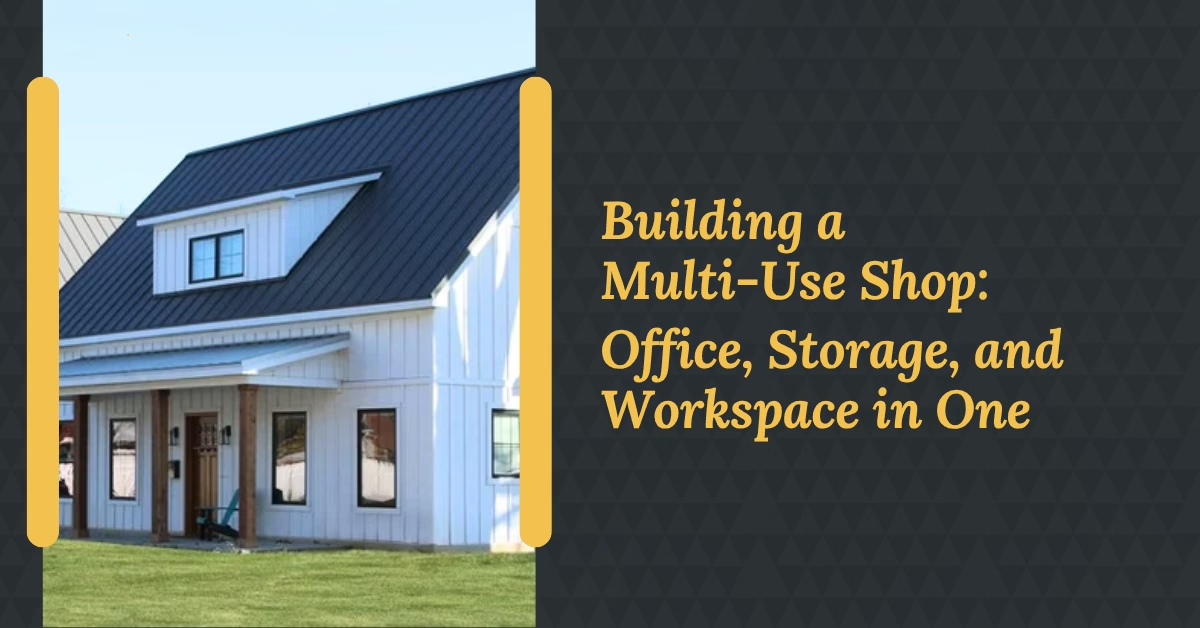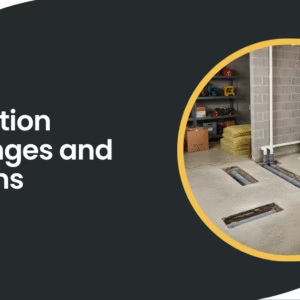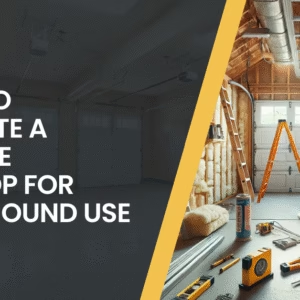A few years ago, Mark, a small business owner, faced a dilemma many of us know well. His garage was packed with tools, boxes, and files. His office was a cramped corner of the living room, and his storage needs kept growing.
Juggling work tasks, inventory, and equipment in scattered spots made daily operations a headache. He needed space—but not just any space. Mark dreamed of a multi-use shop where he could work, store supplies, and meet clients without feeling like he was losing his mind.
Sound familiar? If you’ve thought about creating a shop with office space or a shop and storage combo, you know this challenge well. Luckily, multi-use shop ideas can solve this problem in ways that are practical and even enjoyable. Let’s explore how you can build a space that fits all your needs under one roof.
Why a Multi-Use Shop Makes Sense
Let’s be honest: renting multiple locations or constantly expanding your home for work stuff can get expensive and complicated. If you need a workspace, a spot for your office tasks, and enough room to store tools and materials, splitting these areas can cause chaos. That’s where the multi-use shop comes in.
Picture a single building designed thoughtfully to serve all your purposes. It’s not just a trendy concept but a practical one. You get better organization, lower overhead, and a workflow that feels manageable. Whether you’re a hobbyist or a small business owner, more people are opting for this setup. But turning the idea into reality means careful planning. To help, here are seven key levels to guide your build, making sure your shop and storage combo work for you without headaches.
1. The Foundation: Planning with Purpose
Before breaking ground or drawing plans, it’s crucial to outline your specific needs and priorities. What activities will take place in your shop? How much office space do you require? What storage solutions will support your inventory or tools?
Careful planning avoids costly mistakes later and confirms your space functions effectively. Start by answering questions like
- How much area should be dedicated to active workspace versus quiet office zones?
- What types of equipment or materials need permanent storage?
- Will you meet clients or collaborators here, requiring a professional office environment?
- What are your workflow patterns, and how do you move between tasks?
Clarifying these details sets a strong foundation for your build and influences everything from layout and lighting to electrical needs.
2. Zoning Your Space: The Three-Zone Rule
Dividing your shop into clear zones is one of the smartest ways to maintain order and improve productivity. A common approach is the three-zone rule:
- Office Zone: This area should be quiet, clean, and organized to promote focused work. Include essentials like a desk, computer setup, and filing cabinets. Consider sound insulation to reduce distractions from the workshop area.
- Storage Zone: Dedicated shelves, bins, and labeled drawers optimize space and keep supplies accessible. Vertical storage maximizes limited floor space. Use wall-mounted racks or cabinets for larger items.
- Work Zone: The active area where hands-on tasks, assembly, or crafting take place. Confirm ample bench space, tool access, and proper ventilation.
Proper zoning prevents clutter from spreading and helps maintain a workflow that mirrors your daily routine. It also supports mental separation between different types of tasks, reducing stress and increasing efficiency.
3. Smart Storage Solutions
Storage is often the overlooked part of shop design—until you lose track of a critical tool or part. Combining storage cleverly with your workspace is key.
Try using overhead racks for things used only occasionally. Rolling carts can keep daily essentials handy. And don’t underestimate the power of labeling everything—even the “miscellaneous” box.
Wall-mounted brackets, slat walls, and modular cabinets allow flexibility as your needs change. These smart shop design ideas make your space feel bigger and keep clutter at bay.
4. Designing an Efficient Office Corner
Your office corner in the shop deserves just as much attention as the workbench. It’s where you’ll handle calls, plan projects, and focus on tasks needing concentration.
Good lighting is a must—natural light if possible, or bright LEDs. Comfortable seating and minimal distractions help your brain switch gears from “workshop mode” to “office mode.” Sound insulation or simply distancing the office from noisy tools can make a big difference.
If space is tight, consider fold-down desks or furniture that doubles as storage. The goal is to make the office corner feel like a real workspace, not an afterthought.
5. Lighting, Climate, and Comfort
Because a multi-use shop is more than a storage shed, comfort plays a vital role in how effectively the space supports your work. Consider:
- Climate Control: Depending on your location, install HVAC or portable heating and cooling to maintain consistent temperatures. This protects both you and your materials.
- Lighting: Combine natural light with warm ambient lighting near the office and bright LED task lights in the work zone.
- Airflow: Good ventilation reduces fumes and dust, improving health and focus.
- Ergonomics: Use anti-fatigue mats for standing workstations and set up adjustable furniture to reduce strain.
- Extras: Small touches like a speaker for background music or a mini fridge for refreshments can boost morale.
Comfortable conditions encourage longer, more productive work periods and make the shop a pleasant place to spend time.
6. Power, Plumbing, and Connectivity
A beautiful, organized space won’t function well without the right utilities. Think about your power needs: plenty of outlets, dedicated circuits for heavy tools, and smart placement to avoid tangled cords.
Reliable internet is a must for the office area. Whether Wi-Fi or wired, lagging video calls are a frustration nobody needs. Plumbing might seem extra, but even a simple sink can make cleanup easier.
Don’t skimp on these essentials. They’re the invisible backbone that keeps your multi-use shop running smoothly.
7. Personalizing Your Shop for Workflow Efficiency
One of the best advantages of building your multi-use shop is customizing it to fit your unique work style. Think about how you operate and modify the space accordingly.
- Mobile workbenches or tables that can be repositioned to accommodate various projects.
- Technology setups, such as monitors for presentations or digital design
- Specific storage bins for order fulfillment or parts sorting.
- Inspiration boards, whiteboards, or digital assistants to keep ideas flowing.
- Comfortable areas for breaks or quick meetings.
Your shop should be a reflection of your work habits and support your productivity rather than forcing you to adapt to a generic space.
Wrapping It Up
A well-thought-out multi-use shop is more than just a workspace—it’s a practical answer to the everyday chaos of juggling tools, tasks, and paperwork. By combining an office, storage, and work area under one roof, you create a space that supports your productivity without the clutter or compromise.
If you’re planning from scratch or exploring shop remodeling options, take the time to define your needs clearly. That’s where true efficiency begins.
Exploring various multi-use shop ideas can help you unlock potential you didn’t even know your space had. From smart zoning to flexible storage, every small decision adds up to a big difference.
In the end, this isn’t just about building a shop. It’s about designing a lifestyle that works better—one where everything you need is right where it should be.
Ready to take the next step? Start with a clear plan, focus on your needs, and build a shop that finally brings order to your work life at LegacyHomeSolutionsUS.com.
FAQs
1. How much space is ideal for a multi-use shop?
Most people find 600 to 1,200 square feet sufficient to comfortably accommodate office, storage, and work areas, depending on project scale and equipment needs.
2. What type of flooring works best in a multi-use shop?
Epoxy-coated concrete is durable, easy to clean, and professional-looking. It withstands heavy foot and tool traffic while being suitable for both workshop and office areas.
3. Can a multi-use shop be insulated for year-round use?
Absolutely. Proper insulation combined with drywall and HVAC or heating systems can make the space comfortable and functional regardless of external weather conditions.
4. Are there zoning or building codes to consider?
Yes, it’s crucial to check local building and zoning regulations, especially if the shop will be used commercially or built on residential property. Permits may be required.
5. What technology is recommended for a shop with an office and storage?
Security cameras, smart lighting, Wi-Fi or wired internet, and climate monitoring systems help maintain safety, connectivity, and comfort in the workspace.





